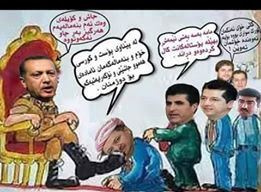The rise and fall of Zionism in Iran Fascinating article by Lior Sternfeld in HaSepharadi about the 20th century split in the Iranian Jewish community over Zionism. After 1948, the question of Zionism became inseparable from any Jewish matter in Iran.
The Alliance Israelite Universelle girls' school in Tehran in 1947 (Photo: AIU/ Diarna)
Starting in the 1920s, sympathies towards Zionism and different interpretations of Zionism started to split the various communities. For example, Shemuʾel Ḥayyim, a leader in the Jewish community, a Zionist, and the Jewish representative to the Majlis, had a harsh disagreement with another Jewish dignitary, Loqman Nahurai. While Nahurai espoused the interpretation, and perhaps practice, that Jews should join full force Zionist international organizations, Ḥayyim believed Zionism to be an overall positive development, but felt Iranian Jews should fight for their rights and status in Iran and not forfeit it for any messianic dream.
Ḥayyim published a newspaper called haḤayyim (Life), in which he preached for integration efforts for the Jews, participation in the political sphere in Iran, and the development of a national consciousness. In a twist of fate, Ḥayyim was actually executed by Reza Shah on account of the false accusations of complying with an attempt to assassinate him. Consequently, any non-Iranian organized movement was banned from operating in Iran.
In 1941, during the Second World War, the Allied Armies invaded Iran. Britain and the Soviet Union occupied Iran, deposed Reza Shah and placed his son, Mohammad Reza Pahlavi, as the new Shah. In the first years of his reign, while British and Soviet forces were still occupying the country, political forces from right and left were allowed to resume their activities, after having been banned or limited during Reza Shah’s period. This was the inception of the Tudeh Party, the Iranian Communist Party, in 1941, and was also the beginning of nationalist-right wing parties in the late 1940s and early 1950s (some of which were decisively fascist) like SUMKA and Pan-Iranist.
Many Jews joined the Tudeh Party, in an effort to combat the social ostracism that had become a divisive issue in the period in which Iranian national identity had started to take shape. At the same time, we start to witness Zionist and Israeli involvement in Jewish life in Iran. Zionist clubs and youth movements were active, yet, Iranian youth did not engage in Zionism, as some Israeli officials had hoped, as it was becoming more complex than it was in 1917.
The twenty-five thousand Iranian Jews that had immigrated to Israel around 1948-1951 were the poorest and neediest of the Iranian Jewish communities. But there were myriad stories at that time of Jews who had immigrated and returned, or immigrated and wanted to return; the important thing to note, was that Iranian Jews overall had a sober idea of what was waiting for them on the other side of the Zionist story (unlike many of the other Middle Eastern Jews).
Inevitably and undeniably, after 1948, the question of Zionism and the state of Israel became inseparable from any Jewish matter in Iran, no matter from which side of the spectrum—Zionist or non-Zionist. It had become increasingly important because of the function of Israel’s alliance with the Shah’s grand vision for Iran. This vision aimed for Iran’s allies to be from the West. Israel, as a Western country, represented much of what the Shah wanted for his own country. Iranian Jews, by association with Israel and by extension, became more vital and instrumental to his nation-building project, than perhaps he intended.
























.jpg)

















































.jpg)






Inga kommentarer:
Skicka en kommentar